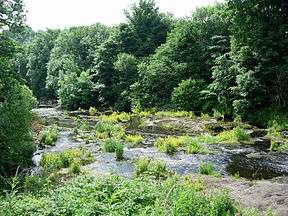Strathgryffe
Coordinates: 55°52′41″N 4°34′26″W / 55.878°N 4.574°W

Strathgryffe or Gryffe Valley (both also spelled Gryfe) (Gaelic: Srath Ghriobhaidh) is a strath centred on the River Gryffe in the west central Lowlands of Scotland.
The river and its strath extend over the historic county of Renfrewshire. Strathgryfe, anciently a feudal lordship, is associated historically with the origins of the county and was anciently the name was used not only for the Strath of Gryffe itself, but for the whole of Renfrewshire.[1][2] The River Gryffe passes through the council areas of Inverclyde and Renfrewshire, rising in Kilmacolm and joining the Black Cart Water between Houston and Inchinnan.
History
The lands of Strathgryffe were granted by King David I to Walter fitz Alan, first High Steward of Scotland, and founder of the Stewart family in Scotland in the 1130s.[3]
Strathgryffe was absorbed into the late medieval county of Renfrew, in which the Stewarts would be based for centuries thereafter.
Name
A Strath is a wide glen. The term is rendered in Scots Gaelic as 'Srath' and in the ancient Modern Welsh as 'Ystrad'.
'Stragrif' is mentioned in the 1169 charter of Paisley Abbey, which placed the churches of the area under the control of the new abbey. Later, the name 'Gryff' is recorded in the Military Survey of Scotland 1747-1755, compiled by William Roy, a predecessor to the Ordnance Survey maps of Great Britain. However it seems that 'Gryfe' was the established usage until more recent times.
The 'Gryffe' name is becoming the predominant usage in the area, seen for example in new signposts showing the name of the river and the names of organisations such as the Gryffe Valley Rotary Club and Gryffe High School in Houston, Renfrewshire.
Settlements
There are a number of villages in Strathgryffe, varying considerably in size. The following straddle or are immediately adjacent to the River Gryffe:
- Kilmacolm
- Quarrier's Village (Kilmacolm civil parish)
- Bridge of Weir
- Houston (including Craigends on the South-east bank of the river)
- Crosslee (Houston and Killellan civil parish)
Geography
The geography of the area is a contrasting mix of green fields surrounding the river, with rough moorland in the higher areas, particularly Clyde Muirshiel Regional Park.[4]
References
- ↑ http://www.scottish-places.info/features/featurehistory3376.html
- ↑ http://www.visionofbritain.org.uk/descriptions/entry_page.jsp;jsessionid=8D89806B61F0A91CBAC0DD4749395848?text_id=138450&word=NULL
- ↑ http://www.visionofbritain.org.uk/descriptions/entry_page.jsp;jsessionid=8D89806B61F0A91CBAC0DD4749395848?text_id=138450&word=NULL
- ↑ http://www.renfrewshire.gov.uk/ilwwcm/publishing.nsf/AttachmentsByTitle/pt-as-Strathgryfe.pdf/$FILE/pt-as-Strathgryfe.pdf